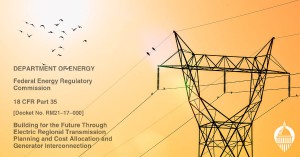The Alphabet of Climate Change from A to Z ~ Now Q for Quagmire

High voltage electrical transmission lines operate up to 765,000 volts, for example.
(Click image to expand).
From the Article by Elizabeth Kolbert, New Yorker Magazine, November 28, 2022
Take what’s been called the “transmission quagmire.” To clean up America’s grid, it’s not enough to build new generating capacity, or even new generating capacity plus new storage capacity. Power has to be transported from places that have a lot of wind and sun to urban centers that use a lot of electricity.
Decarbonizing the grid will, by one estimate, demand more than a million miles of new transmission lines, and the cost of stringing all these lines will, by another estimate, come to more than two trillion dollars. Managing such a gargantuan project would be difficult enough if someone were in charge. But thanks to the way the grid was put together — bit by bit, over many decades — jurisdiction over transmission lines is divided among an electoral map’s worth of competing authorities.
Whenever lines cross state borders, this Q-mire becomes particularly quaggy. In that case, each state’s utility commission has to sign off. In some states, every affected county does, too. Then there are the local utility companies, which may, officially or unofficially, hold veto power.
“Let’s say I’m a local utility, and you tell me all this low-cost power is going to come in from out of state with a new transmission line,” Steve Cicala, an economics professor at Tufts, said to me. “My reaction is ‘Absolutely not. It’s a threat to my business model.’ And a lot of public-utility commissions are pretty much captured by the local utilities.”
The seven-hundred-and-twenty-mile (720 miles) Plains and Eastern Clean Line was supposed to link wind farms in Oklahoma to customers in Tennessee; it was killed by opposition from Arkansas. The Grain Belt Express was designed to run from southwest Kansas to Indiana; it’s been delayed for a decade thanks to resistance from Missouri. The TransWest Express is intended to bring wind power from Wyoming to cities on the West Coast; construction has been held up for years, in good part owing to a single litigious family in Colorado.
Northern Pass was a transmission line designed to bring hydropower from Quebec to Massachusetts via New Hampshire. After New Hampshire rejected the project, in 2018, Massachusetts announced that it would try going in a different direction. It would build a line, dubbed New England Clean Energy Connect, that would cut through Maine instead. Work on NECEC was already under way when, in the fall of 2021, Maine voters approved a referendum effectively killing it. Much of the money spent on campaigning in favor of the referendum — and against NECEC — was supplied by NextEra, which owns the Seabrook Nuclear Power Plant, a potential competitor to the hydro project.
#######+++++++#######+++++++#######
See Also: “Tracking Transmission Reform”– The State Energy & Environmental Impact Center, New York University, School of Law, January 13, 2023
Hear from state attorneys general about why transmission reform is a critical aspect of climate response and what’s at stake, learn about the broad reform needs in this space, and keep track of opportunities to engage in pushing towards more equitable transmission policy.